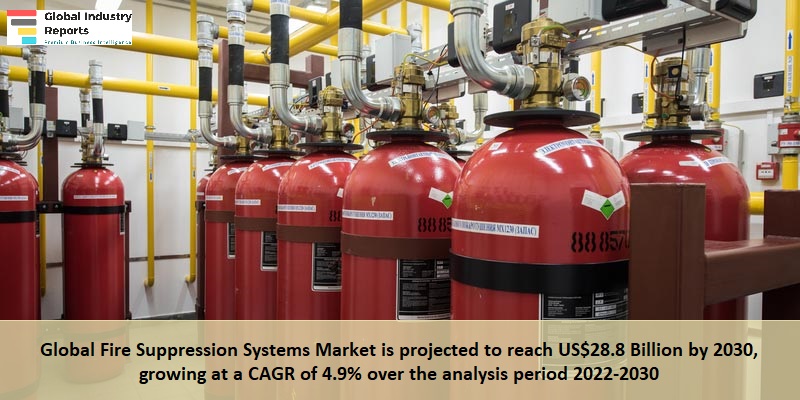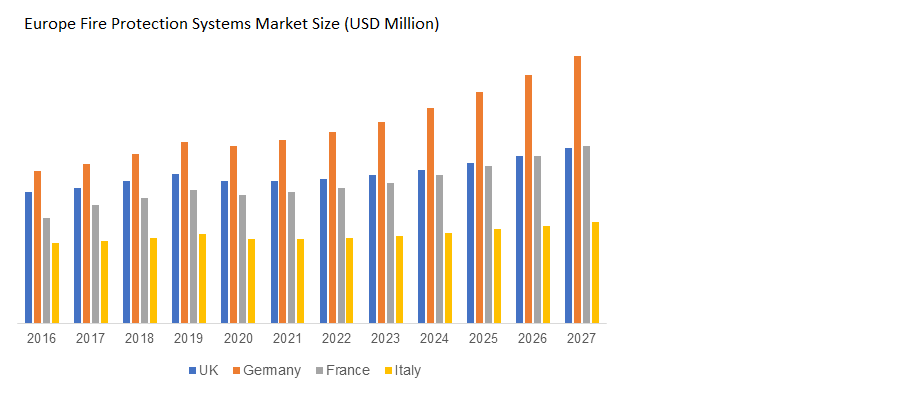Report Overview
- Understand the latest market trends and future growth opportunities for the Fire Suppression Systems industry globally with research from the Global Industry Reports team of in-country analysts – experts by industry and geographic specialization.
- Key trends are clearly and succinctly summarized alongside the most current research data available. Understand and assess competitive threats and plan corporate strategy with our qualitative analysis, insight, and confident growth projections.
- The report will cover the overall analysis and insights in relation to the size and growth rate of the “Fire Suppression Systems Market” by various segments at a global and regional level for the 2010-2030 period, with 2010-2021 as historical data, 2023 as a base year, 2024 as an estimated year and 2024-2030 as forecast period.
Description:
- The global market for Fire Suppression Systems estimated at US$20.8 Billion in the year 2023, is expected to reach US$28.8 Billion by 2030, growing at a CAGR of 4.9% over the analysis period 2023-2030.
- Dry Chemical-Based, one of the segments analyzed in the report, is expected to record a 5.3% CAGR and reach US$11.8 Billion by the end of the analysis period. Growth in the Water-Based segment is estimated at 4.7% CAGR over the analysis period.
- The Fire Suppression Systems market in the U.S. is estimated at US$6.1 Billion in the year 2023. China, the world`s second largest economy, is forecast to reach a projected market size of US$4.2 Billion by the year 2030 trailing a CAGR of 6.2% over the analysis period 2023-2030. Among the other noteworthy geographic markets are Japan and Canada, each forecast to grow at a CAGR of 3.4% and 4.1% respectively over the analysis period. Within Europe, Germany is forecast to grow at approximately 3.8% CAGR.
- The global fire suppression systems market is experiencing significant growth driven by several key trends and factors. The integration of smart technologies and IoT into fire suppression systems is enhancing real-time monitoring and automated responses, improving overall effectiveness. There is a rising preference for environmentally friendly suppression agents, and advancements in fire detection technology are making systems more reliable. Stringent fire safety regulations, increasing construction activities, and heightened awareness of fire hazards are major drivers of market growth, encouraging the widespread adoption of advanced fire suppression solutions to protect life, property, and valuable assets.
MARKET DATA INCLUDED
- Unit Sales, Average Selling Prices, Market Size & Growth Trends
- COVID-19 Impact and Global Economic Recession Analysis
- Analysis of US inflation reduction act 2022
- Global competitiveness and key competitor percentage market shares
- Market presence across multiple geographies – Strong/Active/Niche/Trivial
- Online interactive peer-to-peer collaborative bespoke updates
- Market Drivers & Limiters
- Market Forecasts Until 2030, and Historical Data up to 2015
- Recent Mergers & Acquisitions
- Company Profiles and Product Portfolios
- Leading Competitors
The Report Includes:
- The report provides a deep dive into details of the industry including definitions, classifications, and industry chain structure.
- Analysis of key supply-side and demand trends.
- Detailed segmentation of international and local products.
- Historic volume and value sizes, company, and brand market shares.
- Five-year forecasts of market trends and market growth.
- Robust and transparent research methodology conducted in-country.
- Qualitative and quantitative analysis of the market based on segmentation involving both economic as well as non-economic factors.
- Provision of market value (USD Billion) data for each segment and sub-segment.
- Analysis by geography, region, Country, and its states.
- A brief overview of the commercial potential of products, technologies, and applications.
- Company profiles of leading market participants dealing in products category.
- Description of properties and manufacturing processes.
- marketed segments on the basis of type, application, end users, region, and others.
- Discussion of the current state, setbacks, innovations, and future needs of the market.
- Examination of the market by application and by product sizes; utility-scale, medium scale and small-scale.
- Country-specific data and analysis for the United States, China, Japan, Germany, India, United Kingdom, France, Brazil, Italy, Canada, South Korea, Australia, Russia, Spain, Mexico, Indonesia, Netherlands, Switzerland, Saudi Arabia, Turkey, Taiwan, Poland, Sweden, Belgium, Thailand, Austria, Nigeria, Argentina, United Arab Emirates, Iran, Norway, Israel, Ireland, Malaysia, Denmark, Singapore, Philippines, Pakistan, Finland, Chile, Vietnam, Greece, Czech Republic, Romania, Portugal, Peru, New Zealand, Hungary, Iraq, Bangladesh, Qatar, Kuwait, Ukraine, Egypt, Kazakhstan, Colombia, Angola, Algeria, Morocco, Slovakia, Oman, Puerto Rico, Ethiopia, Sudan, Kenya, Ghana, Dominican Republic, Myanmar, Tanzania, Ecuador, Belarus, Guatemala, Lithuania, Latvia, Sri Lanka, Nepal, Lebanon, Slovenia, Bahrain, Libya and others.
- Coverage of historical overview, key industrial development and regulatory framework.
- Analysis of competitive developments, such as contracts & agreements, expansions, new product developments, and mergers & acquisitions in the market.
- A look at the opportunities in the market for stakeholders and provide a competitive landscape of the market leaders.
Reports Scope and Segments:
| Report Attribute | Details |
| Market size value in 2023 | USD 20.8 Billion |
| Revenue forecast in 2030 | USD 28.8 Billion |
| Growth Rate | CAGR of 4.9% from 2023 to 2030 |
| Base year for estimation | 2022 |
| Historical data | 2015 – 2023 |
| Forecast period | 2024 – 2030 |
| Quantitative units | Revenue in USD million and CAGR from 2024 to 2030 |
| Report coverage | Revenue forecast, company ranking, competitive landscape, growth factors, trends, DROT Analysis, Market Dynamics and Challenges, and Strategic Growth Initiatives
COVID-19 Impact, Market Growth Trends, Market Limiters, Competitive Analysis & SWOT for Top Competitors, Mergers & Acquisitions, Company Profiles, Product Portfolios Market Size, Market Shares, Market Forecasts, Market Growth Rates, Units Sold, and Average Selling Prices. |
| Segments covered | Material, Type, Technology, Platform, Application & Region |
| Regional scope | North America; Europe; Asia Pacific; Latin America; Middle East and Africa and rest of the world |
| Country scope | United States, China, Japan, Germany, India, United Kingdom, France, Brazil, Italy, Canada, South Korea, Australia, Russia, Spain, Mexico, Indonesia, Netherlands, Switzerland, Saudi Arabia, Turkey, Taiwan, Poland, Sweden, Belgium, Thailand, Austria, Nigeria, Argentina, United Arab Emirates, Iran, Norway, Israel, Ireland, Malaysia, Denmark, Singapore, Philippines, Pakistan, Finland, Chile, Vietnam, Greece, Czech Republic, Romania, Portugal, Peru, New Zealand, Hungary, Iraq, Bangladesh, Qatar, Kuwait, Ukraine, Egypt, Kazakhstan, Colombia, Angola, Algeria, Morocco, Slovakia, Oman, Puerto Rico, Ethiopia, Sudan, Kenya, Ghana, Dominican Republic, Myanmar, Tanzania, Ecuador, Belarus, Guatemala, Lithuania, Latvia, Sri Lanka, Nepal, Lebanon, Slovenia, Bahrain, Libya and others |
| Key companies profiled | AFEX Fire Suppression Systems; AI Fire, LLC; APi Group Inc.; Argus Fire Protection Company Ltd; Atomizing Systems Inc.; Bosch Security Systems, Inc.; Carrier Global Corporation; Chubb Fire & Security Ltd.; Consilium AB; EMTEQ Inc.; Encore Fire Protection; Eusebi Impianti s.r.l; Fenwal Controls of Japan, Ltd.; Fike Corp.; Fire & Life Safety America; Fire Suppression Ltd; Fire Suppression Systems; Fireboy®- Xintex® LLC; Fireline Corporation; Firetrace International, LLC; Firetrol Protection Systems, Inc.; Gentex Corp.; Halma PLC; Hochiki Corporation; Honeywell International Inc; Johnson Controls, Inc.; Jomarr Products, Inc.; Kalb Corporation; Kidde Fire Systems; Knowsley SK Ltd.; Marioff Corporation (HI-FOG); Master Fire Prevention Systems; Minimax Viking GmbH; Modular Connections, LLC; NAFFCO FZCO; Napco Security Technologies; ORR Protection; Raytheon Technologies (United Technologies Corporation); Robert Bosch GmbH; RSG Security Inc.; Saudi Sicli Company; Schrack Seconet AG; Securiton AG; Semco Maritime A/S; Siemens AG; Signal Communications Corporation; Space Age Electronics, Inc.; Spectronics Corporation; The Hiller Companies, Inc.; Tyco SimplexGrinnell; United Technologies Corporation (UTC); VFP Fire Systems; Vt Mak and others |
| Customization scope | Free report customization (equivalent up to 20 analyst’s working days) with purchase. Addition or alteration to country, regional & segment scope. |
| Report Format | PDF, PPT, Excel & Online User Account |
Report Segmented by:
Product Type:
- Dry Chemical-Based
- Water-Based
- Foam Based
- Other Chemicals
By Type:
- Active Fire Protection System
- Passive Fire Protection System
By Product:
- Fire Suppression
- Fire Sprinkler
- Fire Detection
- Fire Analysis
- Fire Response
By Service:
- Engineering Services
- Installation and Design Services
- Maintenance Services
- Managed Services
- Other Service
By Vertical:
- Residential
- Commercial
- Academia & Institutional
- Retail
- Healthcare
- Hospitality
- Banking, Financial Services, and Insurance (BFSI)
- Industrial
- Energy & Power
- Government
- Manufacturing
- Oil, Gas, & Mining
- Transportation & Logistics
- Other Industries
By Region:
- North America
- Europe
- Asia Pacific
- Latin America
- Middle East & Africa
- Rest of the World
Companies Covered in Report:
| AFEX Fire Suppression Systems | Kalb Corporation |
| AI Fire, LLC | Kidde Fire Systems |
| APi Group Inc. | Knowsley SK Ltd. |
| Argus Fire Protection Company Ltd | Marioff Corporation (HI-FOG) |
| Atomizing Systems Inc. | Master Fire Prevention Systems |
| Bosch Security Systems, Inc. | Minimax Viking GmbH |
| Carrier Global Corporation | Modular Connections, LLC |
| Chubb Fire & Security Ltd. | NAFFCO FZCO |
| Consilium AB | Napco Security Technologies |
| EMTEQ Inc. | ORR Protection |
| Encore Fire Protection | Raytheon Technologies (United Technologies Corporation) |
| Eusebi Impianti s.r.l | Robert Bosch GmbH |
| Fenwal Controls of Japan, Ltd. | RSG Security Inc. |
| Fike Corp. | Saudi Sicli Company |
| Fire & Life Safety America | Schrack Seconet AG |
| Fire Suppression Ltd | Securiton AG |
| Fire Suppression Systems | Semco Maritime A/S |
| Fireboy®- Xintex® LLC | Siemens AG |
| Fireline Corporation | Signal Communications Corporation |
| Firetrace International, LLC | Space Age Electronics, Inc. |
| Firetrol Protection Systems, Inc. | Spectronics Corporation |
| Gentex Corp. | The Hiller Companies, Inc. |
| Halma PLC | Tyco SimplexGrinnell |
| Hochiki Corporation | United Technologies Corporation (UTC) |
| Honeywell International Inc | VFP Fire Systems |
| Johnson Controls, Inc. | Vt Mak |
| Jomarr Products, Inc. | Others |
After Sales Support
- Every updated edition of the report and full data stack will be provided at no extra cost for 24 months.
- Latest 2023 base year report.
- Free Updated edition of 2024 every quarter without any hidden cost.
- No user limitation for the report. Unlimited access within the organization.
- Unrestricted post-sales support at no additional cost
- Free report customization (equivalent up to 10 analyst’s working days) with purchase. Addition or alteration to country, regional & segment scope
- Global Industry Reports will support your post-purchase for a period of 24 months to answer any of your queries related to the following market and to provide you any more data needed, for your analysis.
- Option to purchase regional or some selected Chapters from the report.
Key questions that are answered in this report
- What is the total market of fire protection systems in 2024?
- What is the total CAGR expected to be recorded for the fire protection system market during 2022-2030?
- What are the driving factors for the fire protection system market?
- Which are the significant players operating in the fire protection system market?
- Which region will grow at a fast rate in the future?
- How big is the Fire Protection System Market?
- What are the Challenges in Fire Protection System Market?
- What is the Restraint in Fire Protection System Market?
- What Company Leading the North America Fire Protection System Market?
- What are Opportunities in Fire Protection System Market?
- Which Region is largest share of Market in Asia Specific?











